You Are Here: Home | Wedding Planning Tips | Real Weddings |
Congratulations on planning your dream wedding! I can imagine the excitement and anticipation as you consider the wedding ceremony processional order. There are so many beautiful details to consider, from who walks down the aisle first to the perfect seating for parents, ring bearers, and flower girls. As someone deeply passionate about weddings and as the proud owner of a wedding venue in Frederick, Maryland, I completely understand the exhilaration and potential overwhelm that can come with this process.
The wedding processional order is more than a mere formality; it’s a cherished tradition celebrating family members and the bridal party. While specific customs may differ by religion, this timeless ritual remains a unique and significant part of the ceremony across various cultures.
Wedding Ceremony Processional Order: Your Planning Guide
The bride’s walk down the aisle is always one of the highlights of a wedding ceremony, but a few other essential people also make their grand entrance. The wedding ceremony processional refers to the group of people walking down the aisle in a specific order to mark the beginning of a wedding ceremony. The wedding processional order often includes the officiant, the wedding party, flower girls, ring bearers, and the bride and groom and their parents.
We’re here to guide you through the various processional orders for different wedding types, ensuring your bridal march will be seamless and joyous!
The wedding processional order holds great significance as it honors both the bridal party and family members. This beautiful and timeless ritual may vary based on religious practices, yet its importance resonates across diverse cultures.
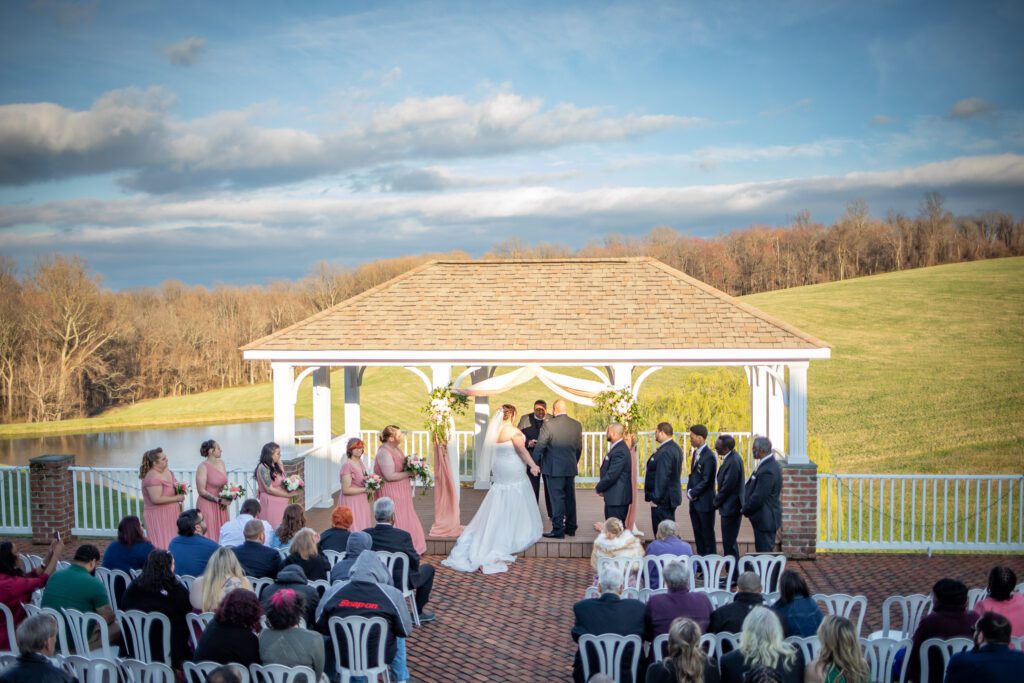
Looking for a wedding venue? Morningside Inn is an all-inclusive wedding venue located on 300 acres in Frederick, Maryland. Learn more about stress-free weddings and how we can help!
Table Of Contents:
- The Ultimate Guide to the Wedding Processional Order
- Traditional Wedding Processional Order
- Traditional Wedding Processional Order
- Key Participants in the Wedding Processional
- Unique Elements in Different Wedding Traditions
- Tips for Planning Your Wedding Processional Order
- Creative Ideas to Personalize Your Wedding Processional
- FAQs in Relation to Order for Wedding Ceremony Processional
- Conclusion
Traditional Wedding Ceremony Processional Order
The order of the wedding ceremony processional varies based on the type of ceremony. However, some key elements remain the same across the board. The officiant usually leads the charge, signaling the start of the ceremony. Then come the grandparents, parents, and the wedding party – groomsmen, bridesmaids, flower girls, and ring bearers. Finally, the moment everyone’s been waiting for – the bride makes her grand entrance, typically escorted by her father or another significant male figure in her life.
It’s a time-honored tradition that’s full of emotion and anticipation. Our wedding venue team always pauses their tasks to witness the wedding ceremony. It’s an emotional and eagerly awaited tradition filled with magic. Being part of this special moment is truly an honor for us, and it’s a magical experience every time. Of course, there’s room to personalize and put your own spin on the processional order. But understanding the traditional sequence is a great starting point.
Christian Wedding Ceremony Processional Order
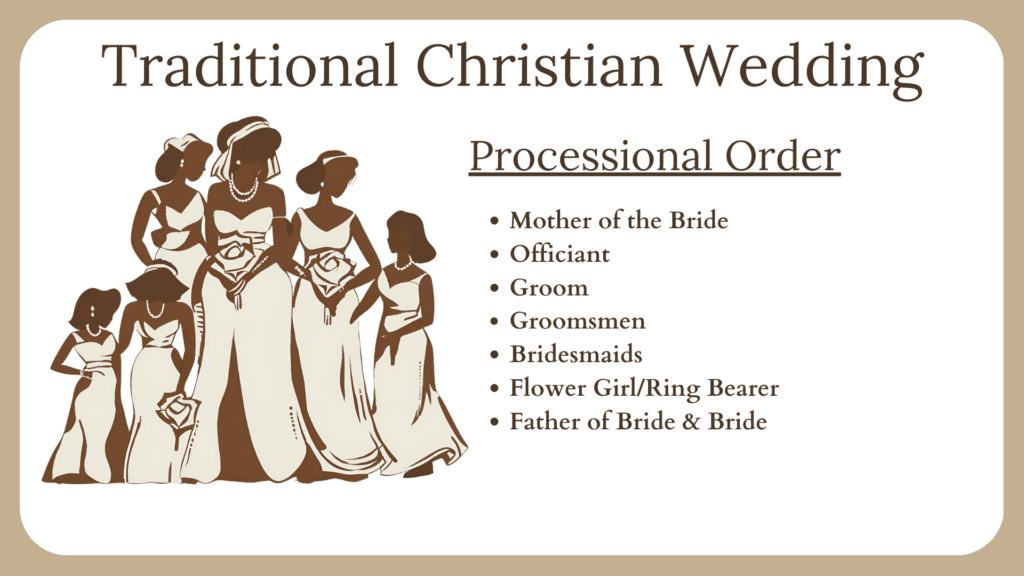
In a traditional Christian wedding ceremony processional, the processional starts with the Mother of the Bride walking down the aisle. Next, the officiant and groom enter from the side and take their places at the altar.
Next up are the groomsmen, often followed by the bridesmaids walking solo or in pairs. The maid of honor then makes her entrance. Any ring bearers or flower girls typically precede the bride. Then all rise for the main event – the bride’s walk down the aisle, usually on her father’s arm.
Before the Christian wedding ceremony processional begins, the groom’s grandparents and parents are escorted down the aisle. This honors these family members.
There’s just something so powerful about that moment when the bride is revealed. All eyes are on her as she makes her way to her groom. I’ve seen some beautiful variations on this, like both parents escorting the bride or even the couple walking in together. But the core essence remains – a meaningful, memorable Christian wedding ceremony processional to start the ceremony.
Jewish Wedding Ceremony Processional Order
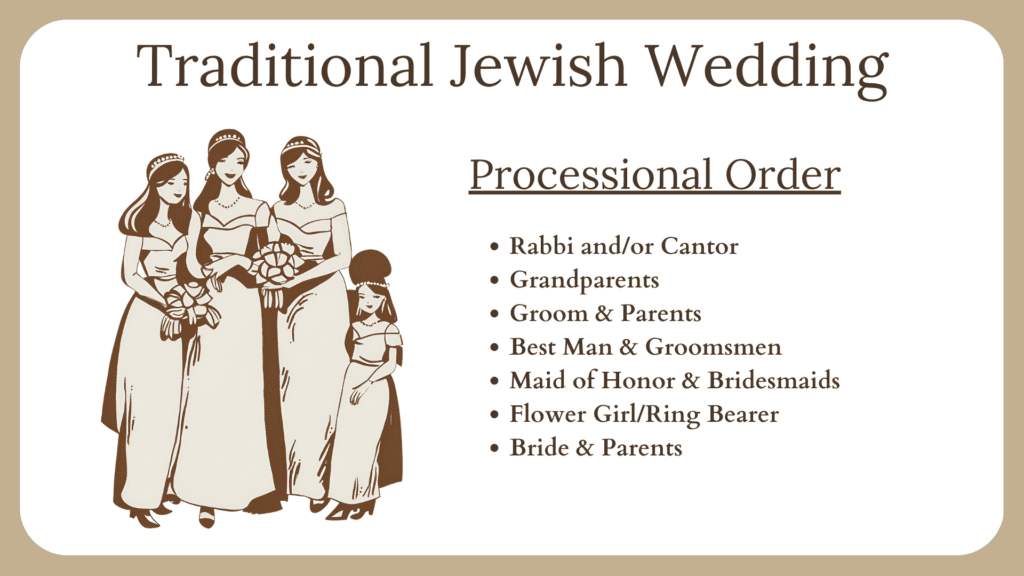
Jewish weddings tend to include more family in the procession than other traditions. The wedding ceremony procession often begins with the officiant, usually a rabbi and/or cantor. Then come the grandparents, followed by a key difference from Christian ceremonies—the groom accompanied by his parents. Next are the groomsmen and Best Man. The bridesmaids and maid of honor then make their entrances. Ring bearers and flower girls are optional but usually included. Finally, the bride is escorted by both her father and mother together.
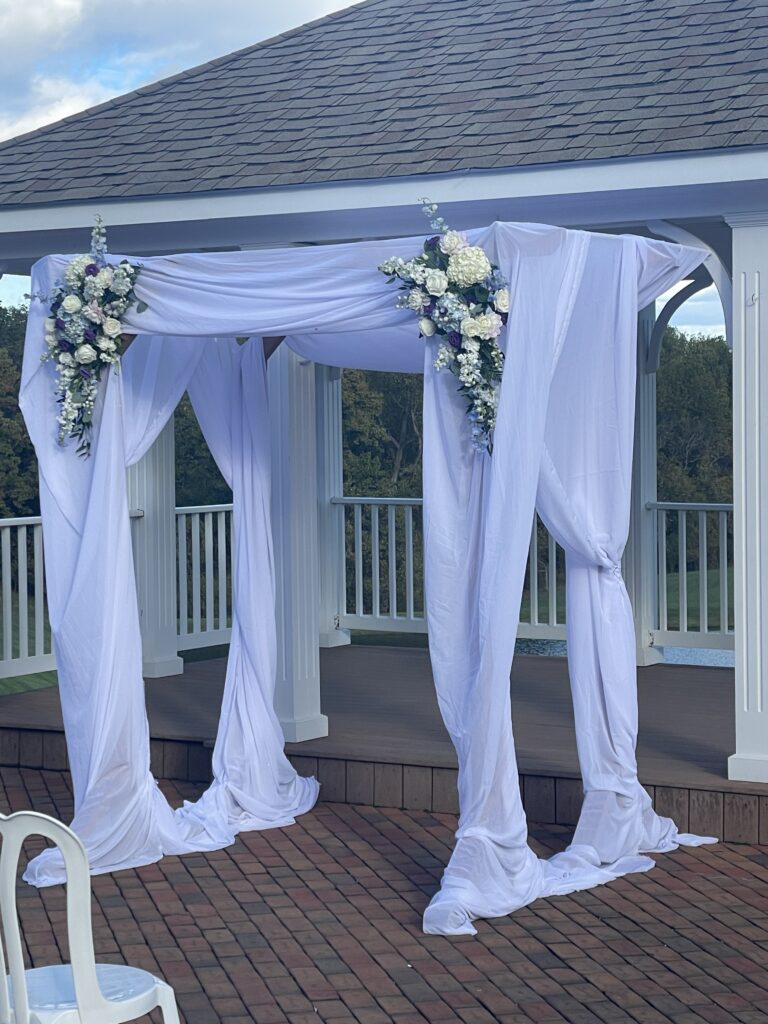
I love how the Jewish wedding ceremony professional honors multiple generations. Having grandparents and parents play such a prominent role highlights the significance of family and legacy. Some couples even have all parents stand under the chuppah (wedding canopy) with them, which I find so moving. It visually represents the joining together of two families.
Hindu Wedding Ceremony Processional Order
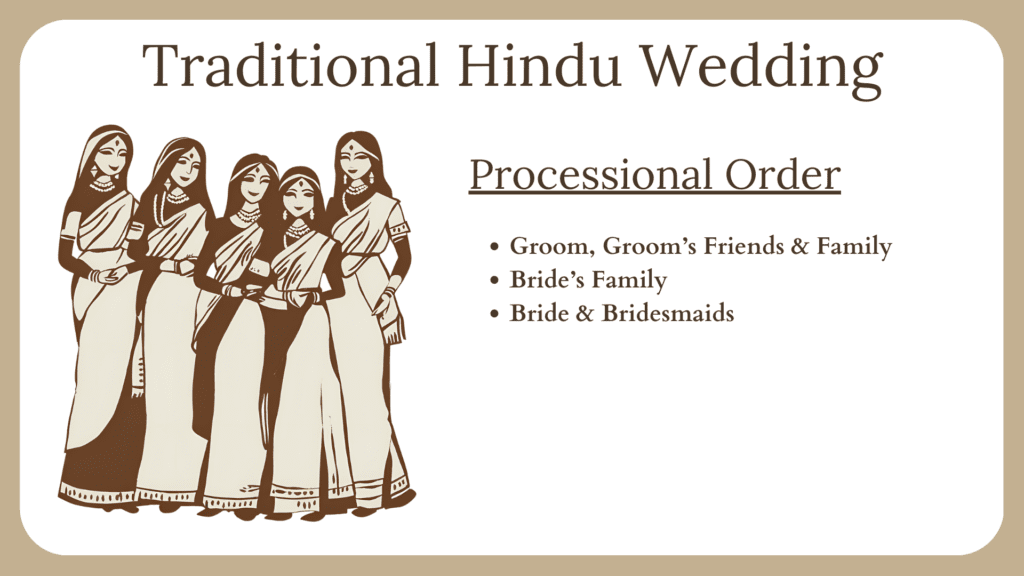
Hindu processions burst with vibrancy and joy, starting with the baraat, where the groom makes his grand entrance. Morningside Inn’s lengthy private driveway is ideal for this tradition. Grooms can arrive in a sleek car, on an elephant, or atop a ceremonial horse.
This marks the start of an extravagant wedding with a parade that’s nothing short of spectacular. Incorporating grandeur and excitement beyond imagination, these events are designed to leave guests in awe. Once they arrive at the ceremony site, the bride’s family greets them, and the parents often exchange garlands and gifts. Then they all head to the mandap, the altar space.
The bride then makes her entrance with her family and wedding party. Siblings or cousins may hold a canopy over her head as she processes. I’m always struck by the celebratory energy of Hindu weddings. You can’t help but smile seeing the groom’s exuberant procession and the bride’s grand, joyful entrance surrounded by loved ones.
Nondenominational Wedding Ceremony Processional Order

Nondenominational ceremonies give you the most flexibility to customize your wedding ceremony processional order. However, many couples still opt to follow the standard wedding ceremony processional structure.
Usually, the officiant enters first, followed by the groom, who may choose to process in with his groomsmen. Then come the bridesmaids, maid of honor, and any ring bearers or flower girls. Finally, the bride enters, escorted by one or both parents or another VIP.
Without the constraints of religious tradition, there’s freedom to get creative. I’ve seen couples walk in together, wedding parties dance down the aisle, even beloved pets serving as ring bearers.
Nontraditional Wedding Ceremony Processional Order
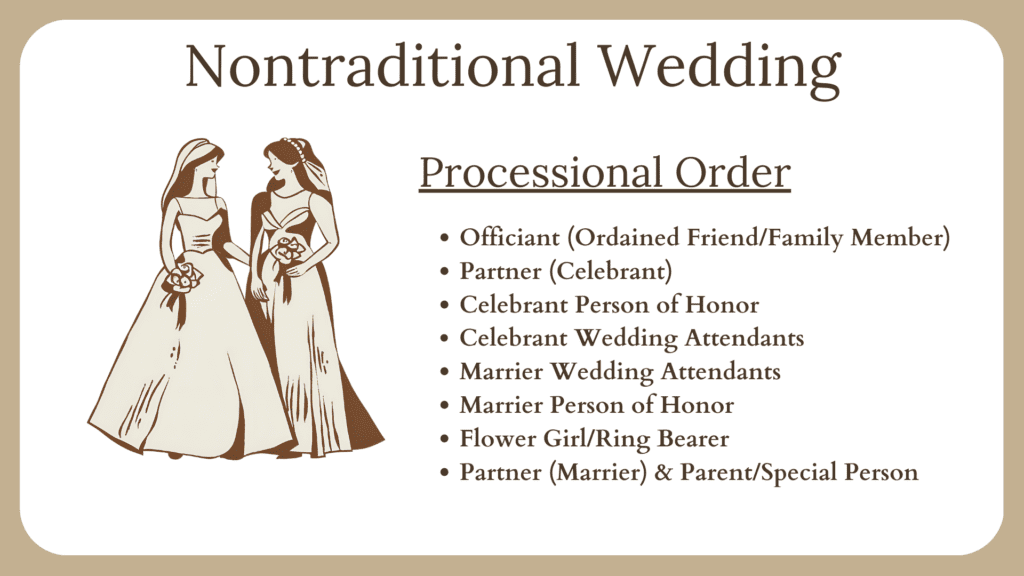
It’s your wedding, and you can buck traditional ceremonies all together and opt for a nontraditional wedding ceremony processional order. The sky is really the limit for this type of wedding, but most of our couples stay with the general theme. The wedding typically begins with the officiant, followed by the wedding participants. Couples may have a friend or family member officiate the ceremony. For same-sex ceremonies, the labels of Bride and Groom labels may be replaced with Celebrant and Marrier. In addition, the Best Man/Maid of Honor may be called a Person of Honor.
The key to the perfect wedding ceremony processional order is to make it feel authentic to you. Honor those you want to honor. Include meaningful touches. And don’t be afraid to break from tradition. At the end of the day, the processional is about setting the tone and kicking off this momentous occasion. Do what feels genuine to you and your partner.
Key Participants in the Wedding Ceremony Processional
While the happy couple are the stars of the wedding processional show, there are some key supporting players who help make the magic happen.
Of course, you’ve got your wedding party – bridesmaids, groomsmen, flower girls and ring bearers. They’re the hype crew getting everyone pumped for the bride’s big entrance.
However, a few other MVPs play a special role in the processional. Let’s break down who they are and why they’re so important. Traditionally, much thought and symbolism goes into every detail of the processional. Each person serves a purpose.
The Bride’s Mother
Ah, the mother of the bride. Is there anything more touching than seeing the woman who raised you beaming with pride as you walk down the aisle?
In many wedding ceremonies, she’s the last person seated before the processional begins, signifying the start of this sacred event. It’s like she’s giving her blessing for it to commence.
I’ve also seen some beautiful moments where the bride stops to hug her mother or give her a flower on her way to the altar. There was not a dry eye in the house, I’ll tell you that.
The bond between mother and daughter is so profound. Acknowledging that in the processional is a powerful thing.
The Bridesmaids or Wedding Attendants
These are your ride-or-die girls. The ones who have been there through thick and thin and will be standing by your side on the biggest day of your life.
Bridesmaids often directly precede the maid of honor in the wedding ceremony processional order. They may walk solo or in pairs.
I love seeing how their dresses complement the bride’s gown and the overall wedding aesthetic. It’s like they’re a beautiful frame enhancing the main picture.
And it’s so fun to see their unique personalities shine as they process. Some are beaming, some are holding back tears, some bust out a little dance move.
They set the tone for the bride’s entrance and build anticipation, which plays such an important role in creating the magic of that moment.
The Maid or Matron of Honor or Person of Honor
This is your VIP bridesmaid—your sister from another mister (or your actual sister)… The one who’s been planning by your side and will be the last friendly face you see before locking eyes with your spouse-to-be.
She usually walks solo right before the ring bearer or flower girl and is the last of the bridesmaids to enter. All the attention is on her for a few special seconds.
I’ve seen maids of honor walk with the best man, hold the bride’s bouquet, and even help fluff her train before she enters. They wear many hats.
But ultimately, they’re there as the bride’s biggest cheerleader and support system. That bond of friendship and sisterhood is so evident in their processional.
The Flower Girl(s) and Ring Bearer(s)
Is there anything cuter than a gaggle of flower girls and ring bearers toddling down the aisle? It’s like a dose of pure joy and innocence in the middle of all the pomp and circumstance. R
Traditionally, the flower girl sprinkles petals to create a pretty path for the bride. The ring bearer carries the precious cargo of the wedding bands (or decoy rings if they’re too little to be trusted.).
But I’ve seen all sorts of adorable variations. Flower crowns, mini tuxedos, even little wagons decked out with garlands. Flower granny is a recent trend. Imagine your grandmother skipping down the aisle tossing rose petals! I’ve also seen siblings pull an infant down the aisle in a cart as the ring bearer. The creativity is endless.
While their role is symbolic, it’s also just so darn heartwarming. The young represent new life, new beginnings, and the beauty of innocence and youth.
Even if they freeze up or go rogue, those kiddos always steal the show in the best way. Definitely a procession highlight.
The Father of the Bride and the Bride
Cue the waterworks because this is the moment everyone’s been waiting for. The big reveal of the bride in all her glory on the arm of her proud papa.
Traditionally, the father “gives away” the bride as a symbol of transferring her care to her new spouse. But many modern brides prefer to think of it more as their dad supporting them as they begin this new chapter.
I’ve witnessed so many sweet moments during this part of the processional. Dads whispering words of encouragement, brides squeezing their father’s arm extra tight, even impromptu hugs that make everyone reach for the tissues.
It’s the culmination of the processional, the big emotional crescendo before the ceremony starts. And it gets me every single time.
Walking your child down the aisle is a profound rite of passage. With every step, you can feel the love and weight of that moment.
Unique Elements in Different Wedding Ceremony Traditions
While the bones of the wedding processional are similar across many traditions, each culture weaves in its own unique elements that make the ritual extra meaningful.
These details tell a story from the specific order of the processional to who is included to what everyone wears. They’re steeped in symbolism and significance.
Learning about these customs has given me such an appreciation for how weddings from all cultures honor love, family, and heritage in their own special ways.
Jewish Wedding Ceremony Tradition: The Ketubah
In Jewish weddings, the rabbi and/or cantor kick off the processional. They often carry the ketubah, the couple’s beautiful marriage contract, as they enter.
Having the officiant lead the charge really sets the tone that this is a sacred religious ceremony. It reminds the couple of their faith being at the center.
I love the gravity that the rabbi’s presence brings. In their processional, you can feel the weight of thousands of years of tradition and the sanctity of the marriage covenant.
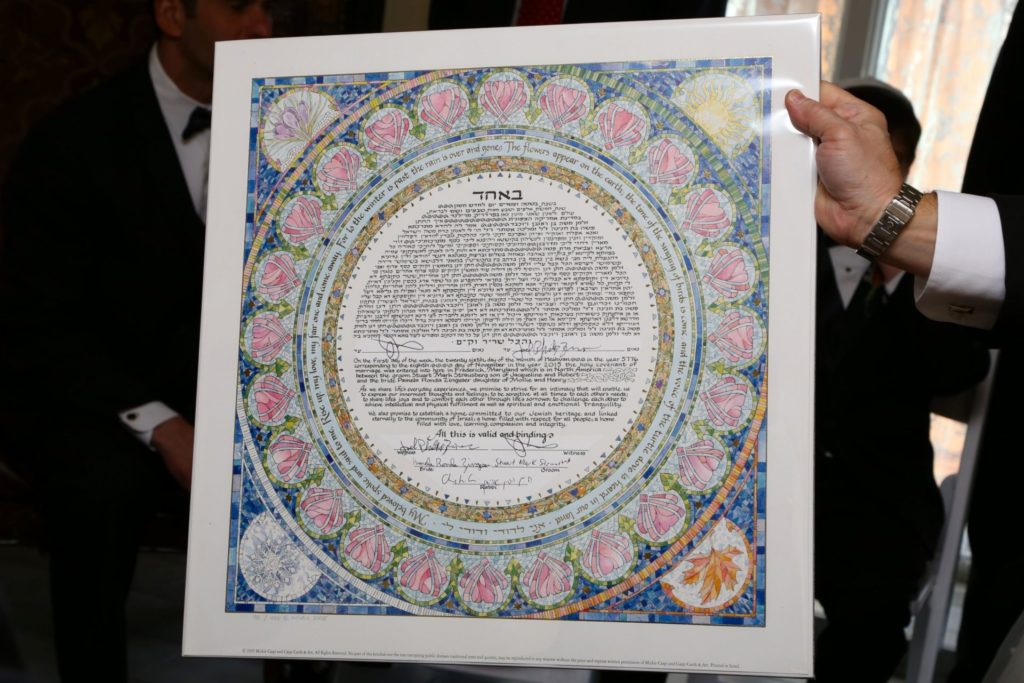
Plus, the ketubah is often a work of art in itself, with intricate calligraphy and designs. Seeing it processed in with such reverence is so impactful.
It’s a beautiful reminder that while the wedding is a joyful celebration, it’s also a deeply spiritual and binding commitment. The rabbi and cantor help anchor that truth.
Latino Wedding Ceremony Tradition: Wedding Lasso
The lasso ceremony is a unity ritual traditionally featured in Latino wedding ceremonies. Beyond exchanging vows, many couples incorporate unity rituals in their weddings to symbolize the bond of their partnership.
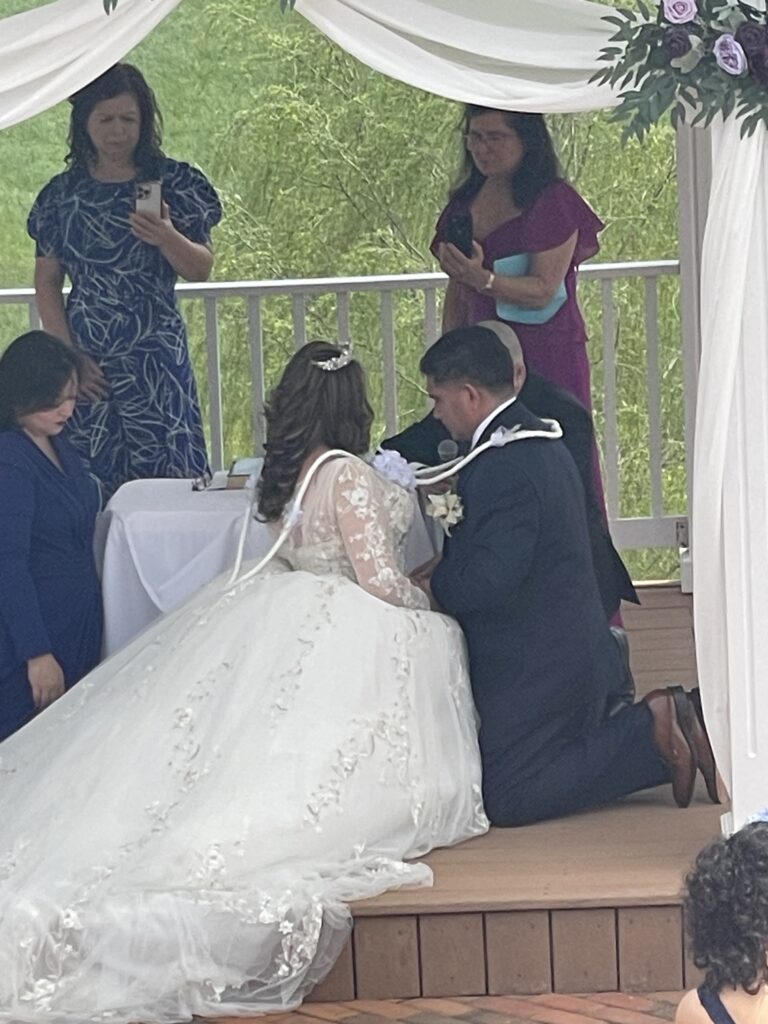
African American Wedding Ceremony Tradition: The Jumping of the Broom
Jumping over a specially designed broom is a tradition deeply rooted in African American history. Originating during times when slaves were prohibited from legally marrying, this act served as a public declaration of love and unity in secret ceremonies. Today, many couples include this meaningful gesture in their weddings, leaping over beautifully crafted brooms to signify their entrance into married life together.
African American Wedding Ceremony Tradition: Tasting the Four Elements
The Tasting of the Four Elements is another poignant ritual where couples experience four distinct tastes representing different seasons of marriage: spiciness (cayenne), sourness (lemon), bitterness (vinegar), and sweetness (honey). This symbolic act underscores their readiness to embrace all aspects of life’s journey as partners.
The wedding processional sets the stage for your big day. It includes key figures like grandparents, parents, and the bridal party. Each tradition adds unique touches to this momentous event. From Jewish ceremonies that involve multiple generations to Hindu weddings filled with vibrant celebrations—personalize it to make it yours.
Tips for Planning Your Wedding Processional Order
When it comes to planning the order for the wedding ceremony processional, I’ve seen firsthand how overwhelming it can be. But after being part of countless weddings, I’ve learned that the key is to break it down into manageable steps.
The first thing I always recommend is consulting with your wedding planner. They’re the experts in all things wedding planning and can guide you through creating a processional order that flows smoothly and sets the tone for your big day. Our venue provides a complimentary wedding planner and day-of coordinator for our couples and a planning guide to help in this process.
Consider Your Wedding Style and Venue
Your processional order should complement your wedding style and venue layout. A formal church wedding may call for a more traditional order, while a relaxed county wedding venue ceremony allows for more creativity.
Communicate with Your Bridal Party
Clear communication is crucial during the processional. Make sure your bridal party knows their roles, the order they’ll be walking in, and any specific instructions.
I’ve found that providing a written outline and reviewing it during the rehearsal helps everyone feel more confident and prepared. It’s also a good idea to assign someone, like your planner or a trusted friend, to cue each person when it’s their turn to walk.
At our wedding venue in Maryland, Morningside Inn, our Wedding Coordinator takes the stress out of this step. She takes the lead at the provided 1-hour Rehearsal, which is included in our site rental fee. She will line up the bridal party in the correct order and guide the entire wedding party through the processional and recessional stage at the rehearsal and on the day of the wedding. Remember, your processional is the grand entrance to your ceremony. Taking the time to plan and practice will help create a memorable moment for you and your guests.
Creative Ideas to Personalize Your Wedding Processional
While traditional processional orders are still popular, I always encourage couples to find ways to make their ceremony entrance uniquely their own. After all, your wedding should be a reflection of your love story and personality.
Here are a few creative ideas I’ve seen couples incorporate to personalize their wedding processional order:
Incorporate a Unity Ceremony
Consider integrating a unity ceremony into your chrisitian wedding ceremony processional. I once saw a couple have their mothers light unity candles at the altar as the couple walked down the aisle, symbolizing the joining of their families. It was a beautiful and meaningful moment.
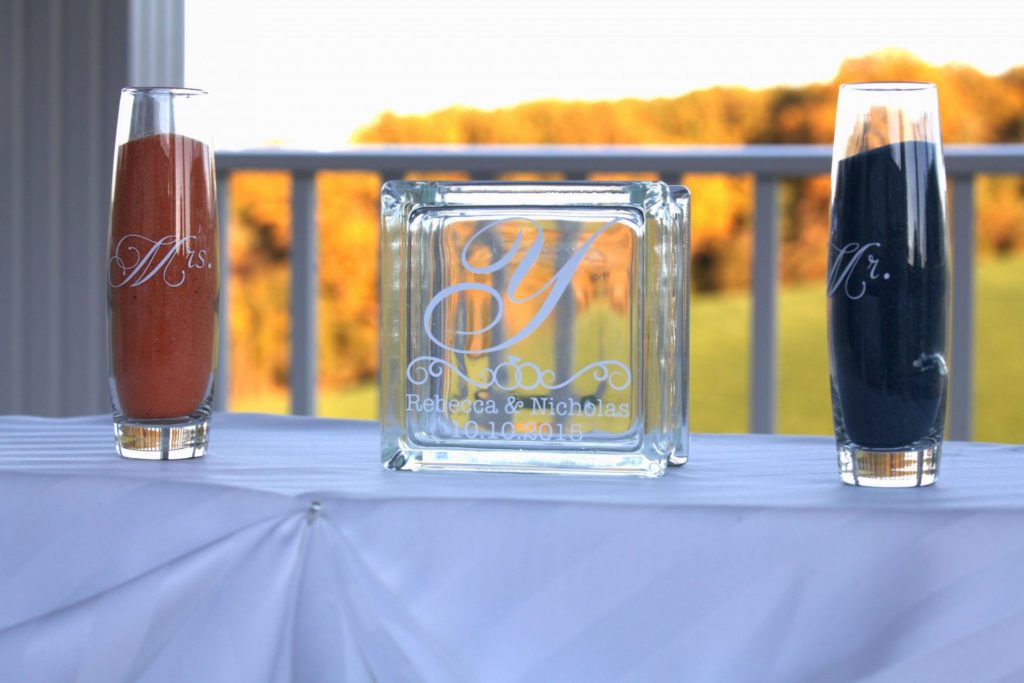
Other unity ceremony ideas that could be incorporated into the wedding procession include handfasting, sand pouring, or a wine box ritual. This is a unique way to add an extra layer of significance to your entrance. As an extra benefit the sand container is a special keepsake.
Plan a Unique Ceremony Exit
Your ceremony exit also called the recessional, is another opportunity to get creative. For a playful twist, have guests blow bubbles or wave ribbon wands as you make your way back up the aisle.
Mix Up the Order of Party Members
Don’t be afraid to switch up the traditional order of your wedding party. If you have a close relationship with your grandparents, consider having them walk down the aisle as part of the processional. Or, if you have children from a previous relationship, include them in the ceremony by having them escort you down the aisle.
At one nondenominational ceremony I attended, the couple had their siblings walk down the aisle together, followed by their parents. It was a lovely way to honor the important people in their lives.
Remember, your wedding processional is an opportunity to set the tone for your ceremony and infuse it with your unique style. Don’t be afraid to think outside the box and create a moment that truly reflects you as a couple.
Break down your wedding processional planning into steps. Consult with a planner, consider the venue and style, communicate roles clearly, practice during rehearsal, and personalize to reflect your love story.
FAQs in Relation to Order for Wedding Ceremony Processional
Who walks down the aisle, and in what order?
Once the guests are seated, the grandparents of the groom, grandparents of the bride, parents of the groom, and mother of the bride will walk down the aisle. Next is the officiant, groom, and groomsmen, followed by bridesmaids, maid of honor, flower girl(s), a ring bearer(s), and finally, the bride with her father.
What is the order of a wedding recessional?
The couple exits first as newlyweds. Next, come their bridal party—maid or matron of honor leading bridesmaids—and lastly, family members leave last to conclude. The parents of the bride exit first, followed by the parents of the groom, followed by grandparents. The officiant walks before the remainder of the wedding guests.
What is the seating order for a wedding ceremony?
The bride’s family sits on the left side while the groom’s family takes the right. VIPs like grandparents sit upfront; close friends fill rows behind them. The mothers should sit on the aisle seat.
Conclusion
The wedding ceremony processional order may seem like a small detail, but it’s an important part of your big day. By understanding the traditional order and adding your own personal touches, you can create a meaningful and memorable moment for you and your guests.
Remember, there’s no one-size-fits-all approach. Whether you stick with tradition or mix things up, the most important thing is that your processional reflects your love story and your unique style.
So, take a deep breath, grab your partner’s hand, and get ready to walk down the aisle. With a little planning and much love, your wedding ceremony processional will be a beautiful start to your happily ever after.
Morningside Inn is an all-inclusive wedding venue located on 300 acres in Frederick, Maryland. Here’s what we provide:
-Private Quiet Venue for Outdoor Ceremony
-Window-Lined Indoor Ceremony Room for Winter or Rainy Days
-Wedding Planner and Day-Of Coordinator
-Tables and Chairs for Ceremony, Reception, and Dinner
-Linens, Simple Centerpieces, Place Settings
-All Set-Up and Clean-Up
-Serving Staff
-Alcohol and Bartender Staff
and more! Download our Wedding Guide for details and pricing!
